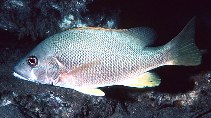| Family: |
Lutjanidae (Snappers), subfamily: Lutjaninae |
| Max. size: |
128 cm TL (male/unsexed); max.weight: 29 kg; max. reported age: 33 years |
| Environment: |
reef-associated; freshwater; brackish; marine; depth range 2 - 40 m |
| Distribution: |
Western Atlantic: Massachusetts, USA to São Paulo, Brazil (Ref. 57756), including the Gulf of Mexico and the Caribbean Sea (Ref. 9626). Eastern Atlantic: St. Paul's Rocks and Ascension Island (Ref. 13121), Tinhosa Grande, south of Príncipe Island (L.A. Pereira (pers. comm.). |
| Diagnosis: |
Dorsal spines (total): 10-10; Dorsal soft rays (total): 14-15; Anal spines: 3-3; Anal soft rays: 8-8. Preopercular notch and knob weak. One of the pairs of canines in upper jaw notably enlarged, visible even when mouth is closed. Pectoral fins long, reaching level of anus. Scale rows on back rising obliquely above lateral line. Presence of a triangular bar between lower edge of eye and rear of mouth. Back and upper sides olive brown with bronze tinge, sometimes with narrow pale bars; lower sides and belly light reddish with a copper tinge. Young with a horizontal blue line below eye which breaks into a row of spots in adults. |
| Biology: |
Adults are common around rocky or coral reefs. Young are found in estuaries and occasionally enters rivers. Feed mainly on fishes and benthic invertebrates, including shrimps, crabs, gastropods and cephalopods. |
| IUCN Red List Status: |
Data deficient (DD); Date assessed: 10 October 2015 Ref. (130435)
|
| Threat to humans: |
reports of ciguatera poisoning |
Source and more info: www.fishbase.org. For personal, classroom, and other internal use only. Not for publication.

